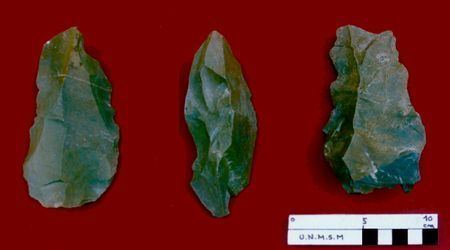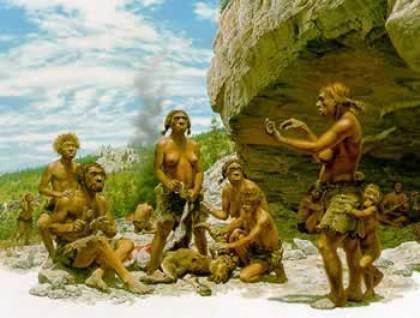Location Chillón valley Periods Preceramic | Length 35 m (115 ft) Excavation dates 1963, 1966, 1970 | |
 | ||
Associated with hunter-gatherers, EL HOMBRE DE CHIVATEROS Archaeologists Thomas C. Patterson, Edward P. Lanning, Claude Chauchat | ||
Ruina de los chivateros pte del inca
Chivateros is an ancient stone tool quarry and associated workshop located near the mouth of the Chillón river in the Ventanilla District, northwest of Lima, Peru.
Contents
- Ruina de los chivateros pte del inca
- Primeros vestigios periodo litico chivateros y toquepala
- Archaeological site
- It is a quarry
- Current status
- References

Primeros vestigios periodo litico chivateros y toquepala
Archaeological site

Excavations were led by archaeologists Thomas C. Patterson and Edward P. Lanning in 1963 and 1966, who noticed three cultural assemblages in the Chillón valley and uncovered large quantities of debris of lithic artifact production, initially interpreted as lithic instruments (hand axes, spearheads, scrapers, etc.).

An area of coastal lomas (areas of fog vegetation), excavations revealed a lithic flake industry as early as the Late Pleistocene, dating between 9,000 and 11,000 years ago. Wood fragments helped define a Chivateros I period of 9500-8000 BC. There is also a red zone with some flint chips which, by comparison of artifacts of the nearby Oquendo workshop, dates to pre-10,500 BC. The whole industry is characterized by burins and bifaces with the upper-level (Chinateros II) containing long, keeled, leaf-shaped projectile points which resemble points from both Lauricocha II and El Jobo. Dating has been aided by the deposition of both loess and salt crust layers which suggest alternating dryness and humidity and which can be synchronized with glacial activity in the Northern Hemisphere.

For a long time it was mistakenly regarded as the greatest lithic workshop in Peru, when in reality it is a large area of canteo, that is to say, a place or quarry where groups of hunter-gatherers paijanenses were supplied with raw materials of the place, in order to make pedunculated tips, known as tips paijanenses or tips Paiján. Popularly the old inhabitant of this area has been called as the Chivateros man.
Exploration of the site's vicinity, the area near the mouth of the Chillon River and the desert around Ancon, revealed a large settlement complex of ancient hunter-gatherers near the quarries and quarry workshop. Among them are Cerro Chivateros, Cerro Oquendo and La Pampilla.
The stratigraphic sequence:
Chivateros was dated by samples of non-carbonized wood associated with the final phase of Chivateros I. Subsequent surveys of French archaeologist Claude Chauchat, in the 1970s, came up with the finding similar sites Chivateros in Cupisnique, managing associate with workshops stemmed points of Paijanense with a dating going back to the eighth millennium BC Later works have It is possible to know that sites on the north coast, of the Chivateros type, date back to the tenth millennium BC.
It is a quarry
Chivateros was initially defined as a gigantic lithic workshop of the Paleolithic. They identified these lithic pieces, made of quartzite, like knives, scrapers, scrapers, arrowheads and hand axes. Moreover, they established a factual differentiation between what they called Chivateros I and Chivateros II, establishing equivalents in other points of America.
Thanks to the works of Chauchat in Cupisnique and Chicama, this interpretation has already been overcome. This archaeologist has determined that Chivateros was actually a quarry, and that there was not only one site of this type, but many Chivateros sites, for much of the Peruvian coast and Yungas (which have been baptized as Chivateros quarries), where groups of hunter-gatherers were supplied raw materials, partially processed rock and took her to their workshops located close to their homes or near the quarries already mentioned.
The most notorious material of these quarries are the Chivateros preforms (erroneously called by Lanning as "Axes of Hand" and "Spearheads"), which were the first outline of pedunculate tips. The rest of lithic materials are nothing more than wastes of the activity of carving and edging.
People who provisioned the raw material Chivateros hill, lived in Pampa Piedras Gordas and in Carabayllo, where Lanning found his workshops and housing areas, baptizing as Lítico Light Complex . There preforms Chivateros type was processed to be converted into pedunculadas tips type Paijanense. This tradition spread along the Peruvian coast from Lambayeque to Ica and covers between 10,000 BC to 6000 BC.
Current status
Since its discovery in the 1960s, Chivateros was constantly plundered by collectors, school and general population to obtain some lithic artifact. In spite of its importance, the Peruvian government never took any plan of care of the site. Subsequently, the activity of private companies and the illegal occupation of land by traffickers has destroyed most of this important archaeological site.
